Dear Reader, in this age of AI created content, please support with your goodwill someone who works harder to provide the human-made. Sign up at the top of the lefthand column or bottom of this page. You will receive my hand illustrated monthly newsletter RESTORE NATURE and access to the biodiversity garden design course as I write...and nothing else, I respect your time. I am also removing the advertizing as best I can as its become intrusive inappropriate and pays me nothing.
Growing carrots in between other organic vegetables
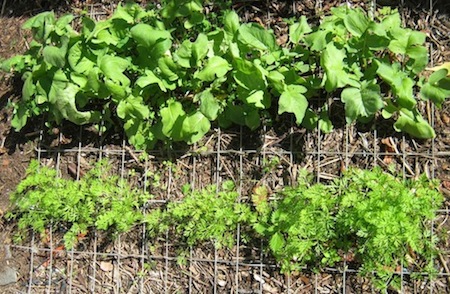 growing carrots near other plants is common practice
growing carrots near other plants is common practiceGrowing carrots is relatively undemanding. They do not require as rich a soil as heavy feeders like the cabbage family, so they are good for planting towards the close of a vegetable bed’s cycle before it is rejuvenated with rich compost.
 don't break your back composting when growing carrots
don't break your back composting when growing carrotsIn our climate carrots can be sown in all months except may to July in the dead of winter and in December, the summer solstice month. I imagine if sown in the latter half of summer, to autumn, they grow through winter, and should be harvested before they bolt and get bitter in spring, and if grown in the first half of summer they can mature through the summer and be harvested anytime up to the next spring.
Growing carrots and direct sowing
When growing carrots its best to sow directly into the soil. I believe it is because their tap root would be damaged by growing in a seed tray. I have not tried doing them in seed trays yet to test this hypothesis. Another reason for direct sowing is that they are also planted very densely to drive their roots downward, as they jostle with their neighbours for root space. This density would be awkward for transplanting from seed tray to bed.
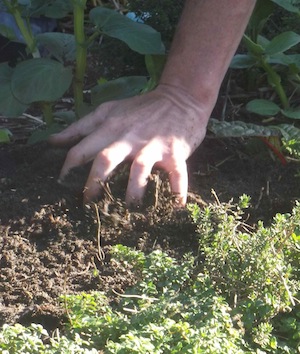 rake off coarse material rake off coarse material |
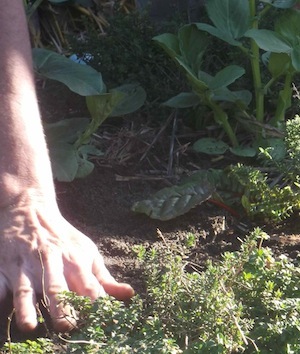 tamp soil gently tamp soil gently |
Carrot seed is very fine, so we have to proceed as for sowing fine seed. Find an area of the bed which is empty. Rake it with a small rake or pick out the course material by hand. Flatten it, pat it down to compress it slightly, and water it well. Then take a dibber or some small sharp object and draw a line through the soil about 2mm deep. This is a very small groove so we have to work delicately. Gently drop a seed into the groove roughly every 2-5 mm as you would sprinkle salt with your fingertips. It is not possible to space it perfectly this way.
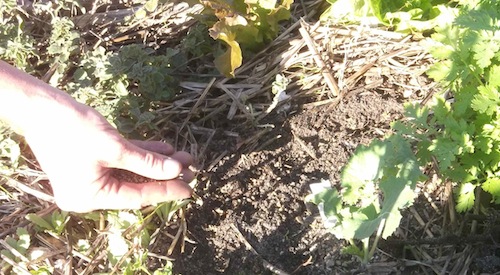 sprinkle seed thinly in a 2mm shallow groove
sprinkle seed thinly in a 2mm shallow grooveSome people recommend using a wet pencil to pick up individual seeds and place them. I’ve tried it and if they adhere to the pencil, they don’t come off on the soil, logically enough, and it would take forever, even if it did work, so I use the sprinkling method. After sowing the seed, gently pinch the two sides of the tiny trench together and pat down very gently. Mark the row with a label so that you don’t forget about the seeds and dig them up.
 After sowing, I cover the ground with wire mesh
After sowing, I cover the ground with wire meshAt this stage, I lay netting wire over the bed because I have a problem with scratching birds, and netting wire really stops them.
 instructions for making this fine sprayer on https://www.greenidiom.com/the-most-gentle-rose-for-watering-vegetable-seedlings.html
instructions for making this fine sprayer on https://www.greenidiom.com/the-most-gentle-rose-for-watering-vegetable-seedlings.htmlIf you water daily with a delicate sprayer like the one I make from recycled materials, the carrots will sprout in 6 -14 days in mild weather, depending on the temperatures outside, according to my planting records for the past 6 months. I have sown my second lot of carrots now and the sprayer works very well, wetting the soil thoroughly without swimming the seeds out of the ground.
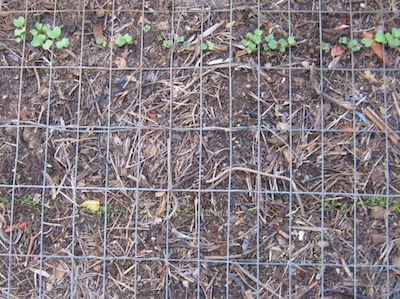 6 days in high summer 6 days in high summer |
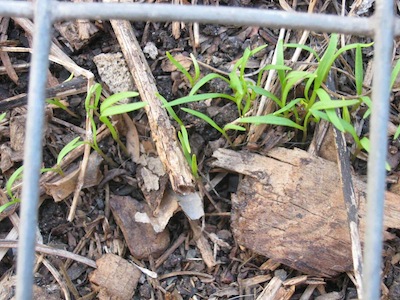 too small ? a close up too small ? a close up |
The growing carrot leaves will soon become luxuriant, and will crowd out smaller plants. This is why they should either be in separate rows or under-plantings with larger vegetable plants. After a month or so pull up one plant carefully without disturbing its neighbours. If they are about 5mm in size, thin the row, pulling every second plant. If the plants are a pinkie width apart, leave them. Continue to thin the growing carrot plants once a month. First you will have baby carrots to use in salads and stir fries, then much later (its been over 4 months now and they are still tiny, even in our hot weather) you will have larger carrots. They take a long time to grow so carrots especially, are suited to being planted between other vegetables where they serve the purpose of covering the ground and can be left in situ for a long time and largely neglected. However I do think its time to harvest the radishes whose leaves may be outcompeting the carrot's foliage, and start feeding with some worm tea added to a sprinkle bottle, as vermicast promotes root and fruit formation.
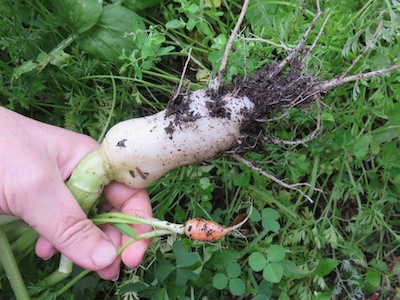 carrot and radish sown at the same time, at ten weeks
carrot and radish sown at the same time, at ten weeksYou can plant carrots in a patch that becomes open between other plants, or interplant them in rows of mature vegetables. Karen Parkin, a professional permaculture gardener in the Cape, showed me how this is done in her gardens. A second crop is sown before the previous one is harvested. By the time the row of older vegetables comes out the second are making headway. Companion planting is used in these combinations as the plants are so close together and one must grow in the other’s shade for quite some time. In a garden ecosystem this can mean protection under the ‘canopy’ and the chemical and biological assistance of the first planting, or it can mean the first planting suppresses the germination or growth of the second. We have to be sure the two plants really get along before putting them together in a succession like this. Carrots produce a lot of foliage for the size of the root. They need to grow with something that can cope with this.
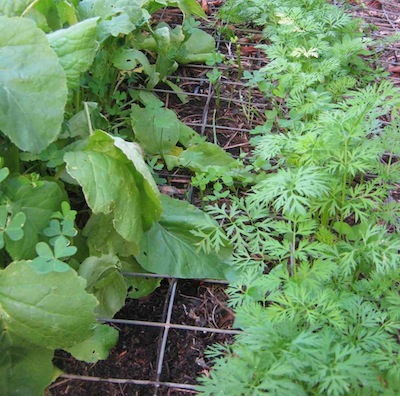 radishes and growing carrots together at 6 weeks
radishes and growing carrots together at 6 weeksCompanion planting guides can be found in your local library, or online. Some of the rules are very helpful and others just hearsay. Some should be strictly adhered to and others only respected in ideal situations. Experience will tell if they work, after many many years. In the interrim we can only trust those who compile such lists, and continually break the rules a little and see what happens. Consider these basics first: do the two plants compete for the same space ? Is there a well known reason why they might be compatible or not ? For example, onions have underground parts that we harvest, and beans take up a completely different space, their fruit is borne on vines. But, it is known that onion family (Alliums) possess antiseptic (bacteria killing) properties. Legumes fix nitrogen with the aid of special resident bacteria in their roots. From these two known properties of the plants concerned it can be deduced they would not be good companions, or at least beans would not thrive in the company of onions, even if it is possible vice versa. Fortunately I have an information source which I can trust. According to my booklet, carrots grow well next to chives, dill, flax, lettuce, leek, onion, parsley, pea, rosemary, sage, tomato and wormwood, and do not harmonize with cabbage, fennel, kohlrabi and potato.
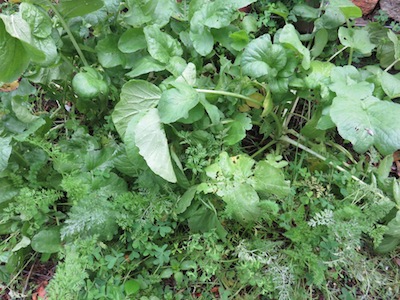 the radish and carrot leaves overlap at ten weeks
the radish and carrot leaves overlap at ten weeks the most delicious carrot harvest at seven months
the most delicious carrot harvest at seven months------
home page for links to lots of useful tips on natural gardening
------
vegetable gardening the natural low cost way, with a list of easy vegetables to grow
You’re a home gardener ! Share your experiences and questions !
We all know about home gardening. Tell us about your successes, challenges and ask about issues that bother you. You may have the luxury of a back garden, but there are other ways we learn. Few people age without growing something or buying vegetables during their lives ! It is absolutely guaranteed that you have learned things which can help others on their gardening journey.
We invite you to share your stories, ask questions, because if a thing has bothered you it will bother others too. Someone may have a solution ! No question is too small. There is learning for everyone involved, for you, for me (yes, I learn from every question), for us all. Exciting stuff !
We are starting on a new journey. Every week we will profile your letters ! The best stories and questions we receive.
What Other Visitors Have Said
Click below to see contributions from other visitors to this page...
thinning carrots 




I was taught how to do this and its one of those things in which being taught gave me confidence. I hope my words will have the same reassuring, guiding …
Restore Nature Newsletter
I've been writing for four years now and I would love to hear from you
Please let me know if you have any questions, comments or stories to share on gardening, permaculture, regenerative agriculture, food forests, natural gardening, do nothing gardening, observations about pests and diseases, foraging, dealing with and using weeds constructively, composting and going offgrid.
SEARCH
Order the Kindle E-book for the SPECIAL PRICE of only
Prices valid till 30.09.2023
Recent Articles
-
garden for life is a blog about saving the earth one garden at a time
Apr 18, 25 01:18 PM
The garden for life blog has short articles on gardening for biodiversity with native plants and regenerating soil for climate amelioration and nutritious food -
Cape Flats Sand Fynbos, Cape Town's most endangered native vegetation!
Apr 18, 25 10:36 AM
Cape Flats Sand Fynbos, a vegetation type found in the super diverse Cape Fynbos region is threatened by Cape Town's urban development and invasive alien plants -
Geography Research Task
Jan 31, 25 11:37 PM
To whom it may concern My name is Tanyaradzwa Madziwa and I am a matric student at Springfield Convent School. As part of our geography syllabus for this
"How to start a profitable worm business on a shoestring budget
Order a printed copy from "Amazon" at the SPECIAL PRICE of only
or a digital version from the "Kindle" store at the SPECIAL PRICE of only
Prices valid till 30.09.2023








